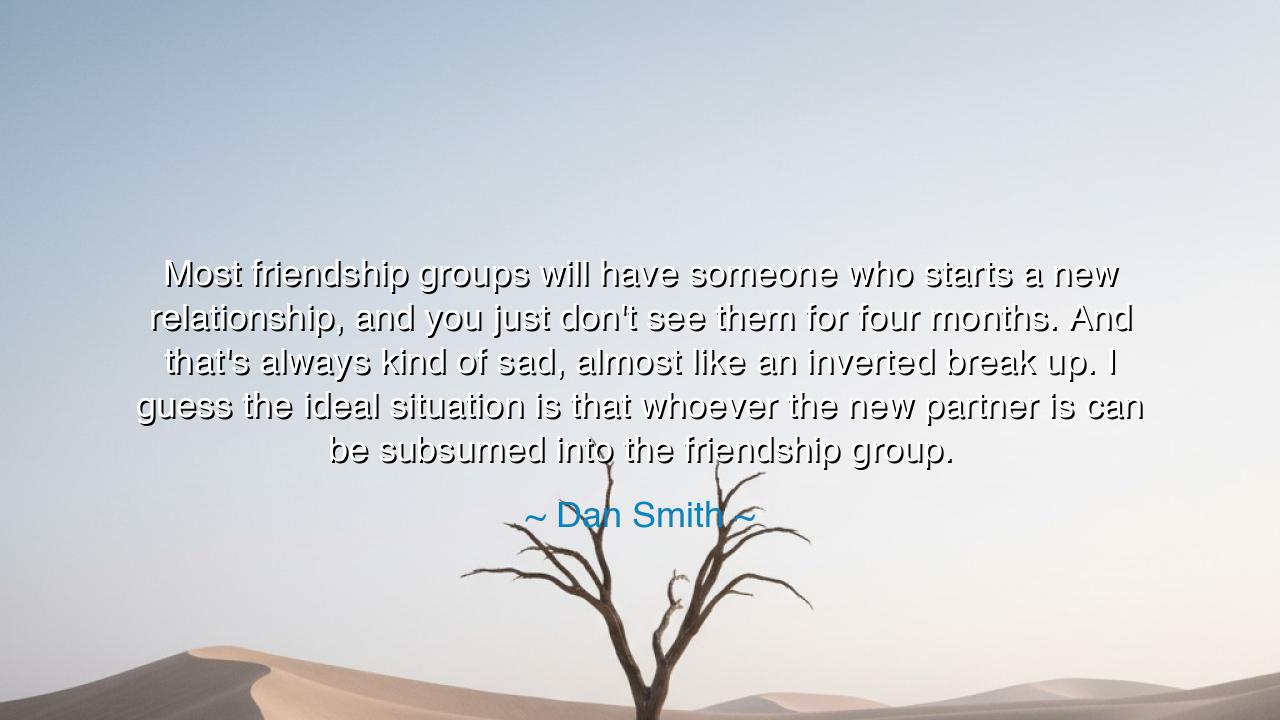
Most friendship groups will have someone who starts a new
Most friendship groups will have someone who starts a new relationship, and you just don't see them for four months. And that's always kind of sad, almost like an inverted break up. I guess the ideal situation is that whoever the new partner is can be subsumed into the friendship group.






Gather around, young ones, and listen closely to the words of Dan Smith, for in his observation, we find a reflection on the fragile and often shifting nature of human relationships. He speaks thus: "Most friendship groups will have someone who starts a new relationship, and you just don't see them for four months. And that's always kind of sad, almost like an inverted break-up. I guess the ideal situation is that whoever the new partner is can be subsumed into the friendship group." These words ring with a deep truth—the way in which romantic relationships can, at times, cast a shadow over the bonds of friendship, altering the balance of a circle that once seemed unbreakable.
In the ancient world, friendships were seen as the very cornerstone of a noble life. Aristotle, the great philosopher, taught that friendship was not merely a bond, but the highest form of human connection, one that transcended the individual and brought people together for mutual growth and virtue. But, as Dan Smith observes, when a new relationship enters the picture, the dynamics of the group can shift. The bond of friendship can be tested, for the once familiar space shared between friends becomes fractured, divided, and sometimes strained. One may leave the circle, consumed by the new love, leaving their companions in a state of longing and sadness—like a shadow creeping over the warmth of shared memories.
Consider, if you will, the friendship between David and Jonathan in the Bible. Their bond was one of the purest forms of friendship—a love so deep that it is described as being greater than that of brotherhood. Yet, even their connection was tested when David was forced to leave for safety, and Jonathan was required to maintain his own duties to his father, King Saul. Though their friendship was never broken, their physical proximity was diminished. The result was a longing for the companionship they had once shared, and a yearning for the days when they could stand side by side in the same fellowship. This, young ones, mirrors the sorrow one feels when a friend, caught up in the whirlwind of a new relationship, withdraws from the circle of old bonds, leaving behind a void.
Dan Smith’s words also highlight the inevitable tension between romantic love and platonic friendship. It is a delicate dance, where the heart must navigate between the pull of a new partner and the need for connection with old friends. In the world today, this tension is ever-present, as we see friendships sometimes falter when the balance tips too far toward one side. There is a yearning, a quiet sadness, when a friend becomes distant, enveloped in the bliss of their new love, as though the very fabric of the group is unraveling. The ancient Greeks understood this well, for even in their greatest stories, they often spoke of the tragic loss of friendship when love, unchecked, consumed the heart.
Yet, Dan Smith also offers a glimmer of hope in his words—the ideal is that the new partner becomes a part of the friendship group. This is the true beauty of friendship: its ability to grow, to expand, and to embrace new people, without losing the essence of what it was before. This act of inclusion, of welcoming the new love into the fold, is one of the highest virtues of community. It takes wisdom and care, for it requires the group to remain open, to recognize that love does not have to isolate, but can instead strengthen the bonds of old ties, weaving them into something greater than before. It is like the Greek notion of philia, that deep, brotherly love between friends, where the bond grows and deepens, enriched by the presence of others.
In the ancient world, the figure of Aristotle himself might have pointed to the strength of a united community, where individuals could form new connections without tearing apart the old. The ideal, as Dan Smith suggests, is to let the new partner integrate, to let friendship and romantic love coexist harmoniously, supporting and enriching one another. This is the foundation of a flourishing society, where each relationship, whether born of love or friendship, serves to elevate the others, weaving a tapestry of shared experience, support, and mutual growth.
So, young ones, the lesson here is clear: cherish your friendships, but understand that the entrance of new love into the circle may challenge the delicate balance of connection. Do not despair when a friend is caught in the thrall of a new relationship; instead, open your heart to the possibility that the bond of friendship can expand, embracing the new partner and creating a stronger, more vibrant connection. Treat this transition with wisdom and grace, and let the circles of love and friendship interlace, creating a web that is unbreakable and full of warmth. In this way, you will not lose the things that matter most, but grow together into a greater union of hearts, bound not by proximity, but by shared care and understanding.






AAdministratorAdministrator
Welcome, honored guests. Please leave a comment, we will respond soon